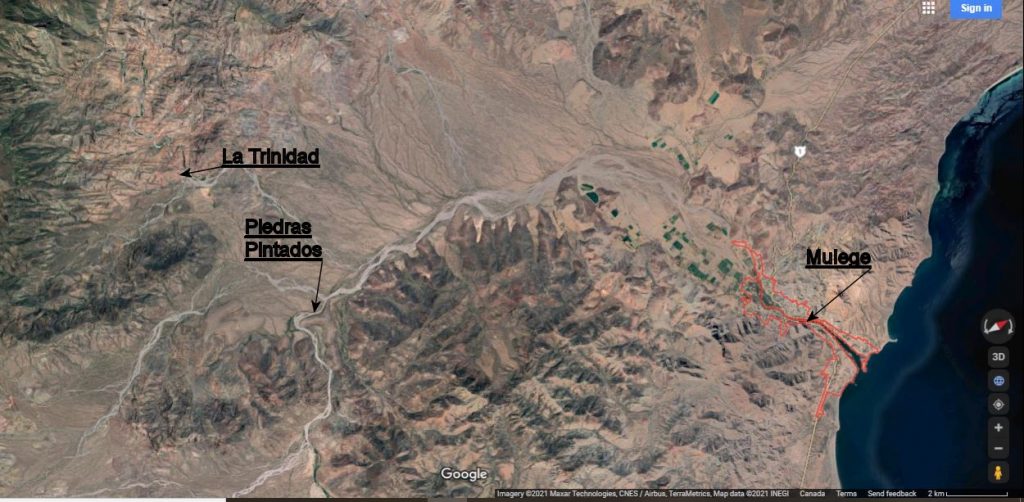
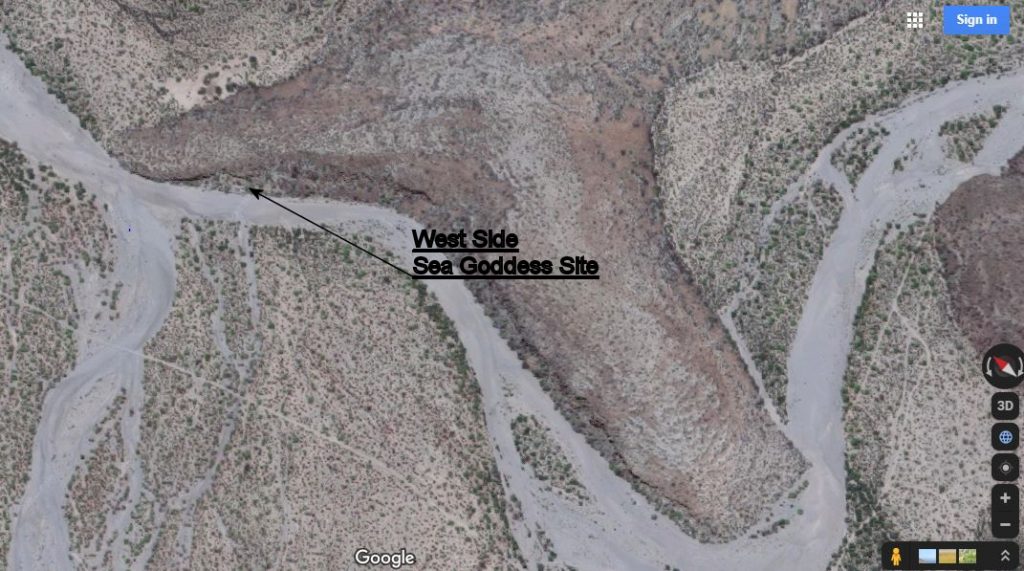
The Sea Goddess Site, (Site 1)
This part of the site is located on the west side of the moraine starting from where the moraine starts to slope up from the level of the arroyo and continues south along the side of the moraine for about 250 meters. Petroglyphs are found from arroyo level to the height of the cliff faces. This part of the site is best viewed in the afternoon allowing the sun to better illuminate the petroglyphs.
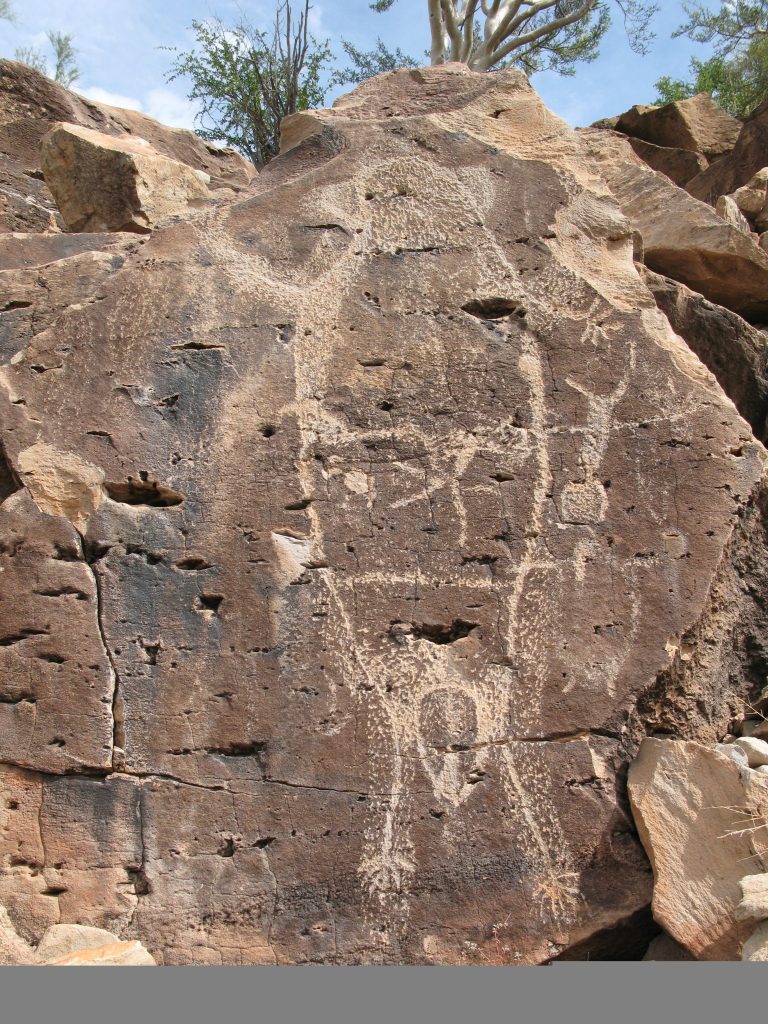
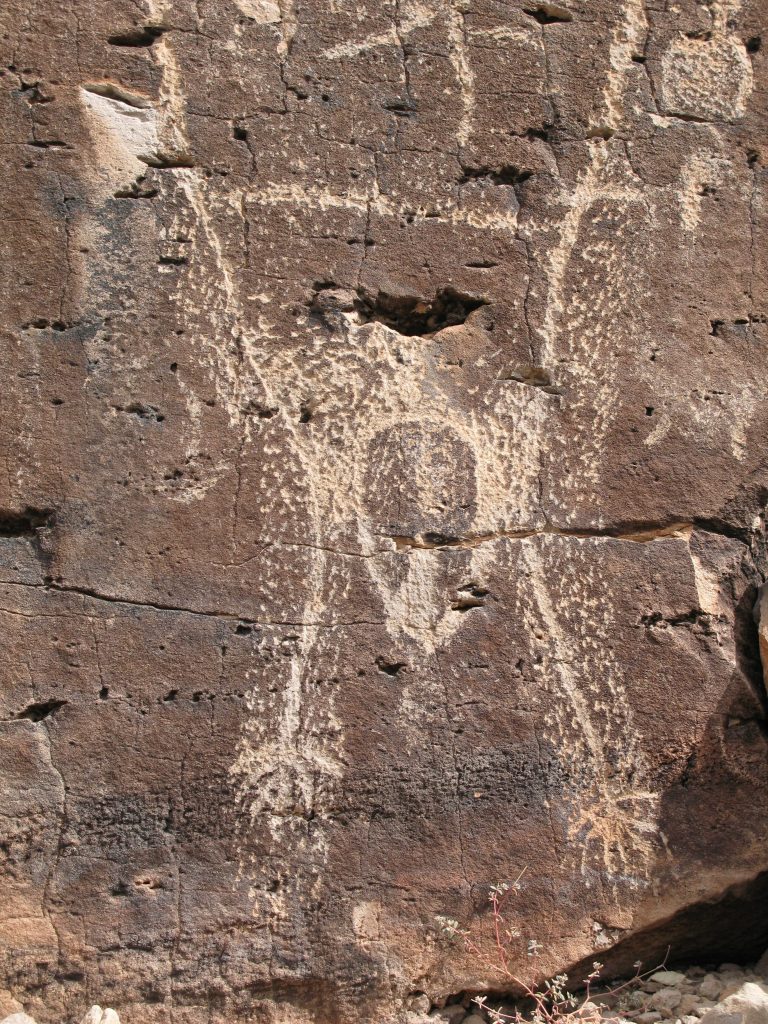
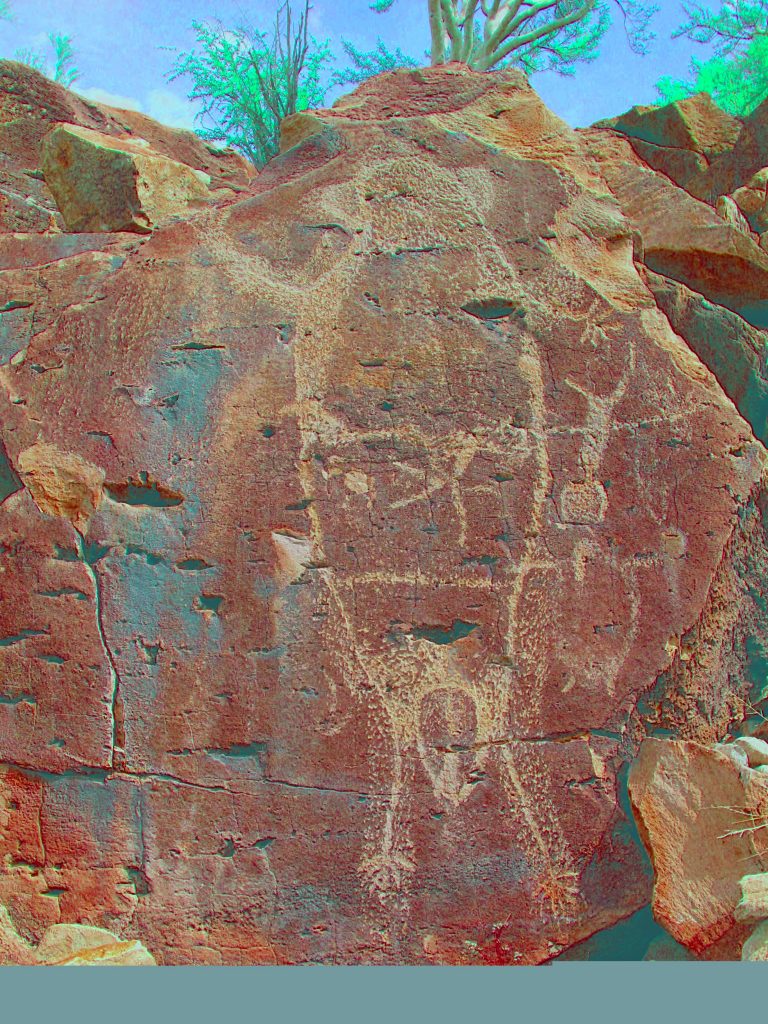
The Sea Goddess
The female figure or Sea Goddess is about 1.6 meters tall and has proportionately enlarged vulva with what could be a forked tail (or small legs) protruding. The head of the figure has no neck, is fully pecked and has two protruding conical appendages (one on each side) which may be a headdress. Within the head there are two holes in the rock about 12mm in diameter and about 15cm apart which could be interpreted as eyes giving the figure the appearance of looking slightly to her right.
Her left hand has six digits and that arm is of short proportions and is angled down below horizontal. The raised right arm is short also and may have six digits. This hand seems to be holding an object that is circular (a fan?) with five upward extending vanes. Superimposed on the right shoulder of the figure is a definite picture of a fish with the head of the fish up and above the shoulder, and the forked tail of the fish at about the middle of the figure. The fish also has two other fins and is fully pecked.
Suspended below the left hand is an unidentifiable object that is fully pecked. Below this small figure there is what could be the shape of a turtle with pecking only on the outline.
There is a horizontal line at mid torso level on the figure that extends (by coincidence?) outside of the figure to the viewers right. Close to the center of this line is a six pointed star shape spanning about 6 inches. There is another horizontal line at what could be waist level and a prominent cleft on the rock where the belly button would be. From this cleft there is prominent pecking that occurs both inside and outside of the lines denoting the limbs and torso of the figure although pecking favors the viewers left side below the cleft. Near what would be the figures left shoulder there is a prominent cleft that has heavy pecking extending upwards towards the figures head and also outwards along the left arm part way. About half way along the arm the pecking turns upwards into an area of the rock that shows signs of being broken away in recent history. Why? Could it be an attempt by a shaman to desecrate the influence of this “creature”? Hmm.
Dark staining on the rock surface is evident extending down below the right arm. There are lightly pecked figures of what could be 3 or 4 fish below the right arm.
An extraordinary figure!
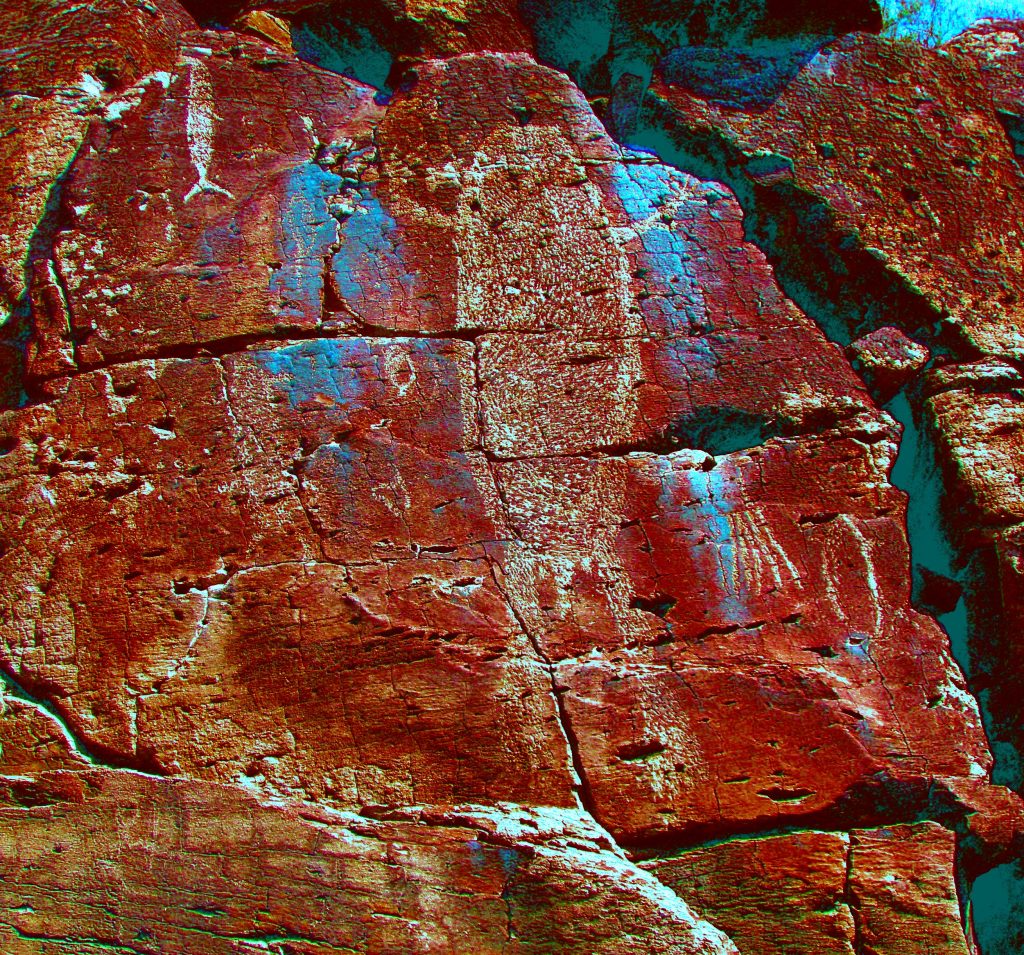
The consort to the Sea Goddess perhaps? Slightly smaller at about 1.3 meters tall. Also seems to have a fan shaped item in right hand that is ‘incorporated’ into a cleft in the rock. This cleft as well as the one by the left hand has staining of the rock surface below. Below the left arm at about waist level is a horizontal cleft in the rock with dark staining emanating from an enlarged hole and five vertical, slightly splayed pecked lines below it. Obvious male genitals. Other glyphs in area. Not as much detail and care given to the drawing of this glyph. Not as revered as the Sea Goddess?
photo WS 04_lrd_ac by author
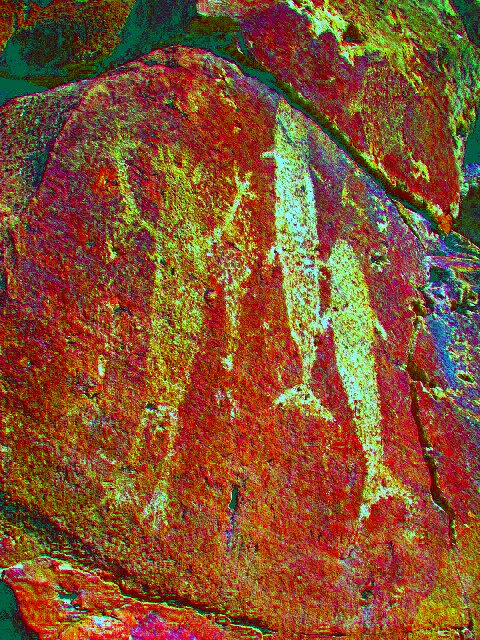
Elsewhere, yet another anthropomorph. This one about 1 meter tall, with a ‘crown’ or similar headdress. Obvious male genitals. The genital area of the rock seems to have portions broken out of it. A virtual castration? Objects seen suspended below both arms. The figure is fully pecked as are the two fish that share this panel.
Photo WS 09_ybr_ac by Bruce Schweers
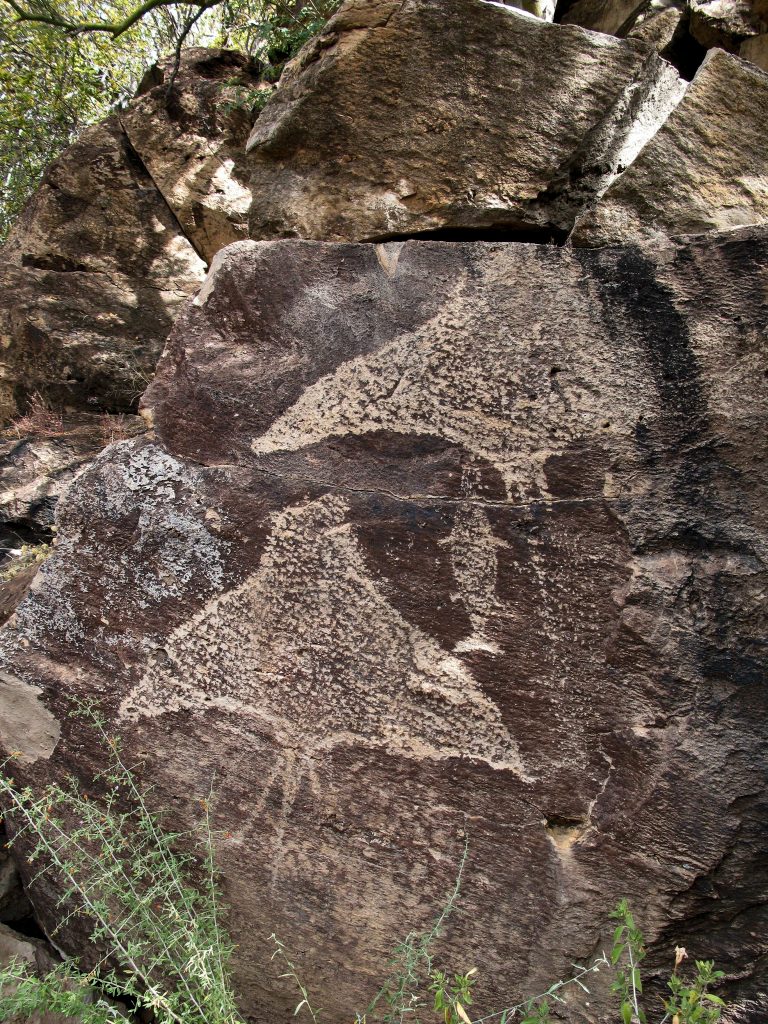
Large Manta Rays, about 80cms wide, with fully pecked interiors. One ray on the right seems to have a fishing line leading to its mouth.
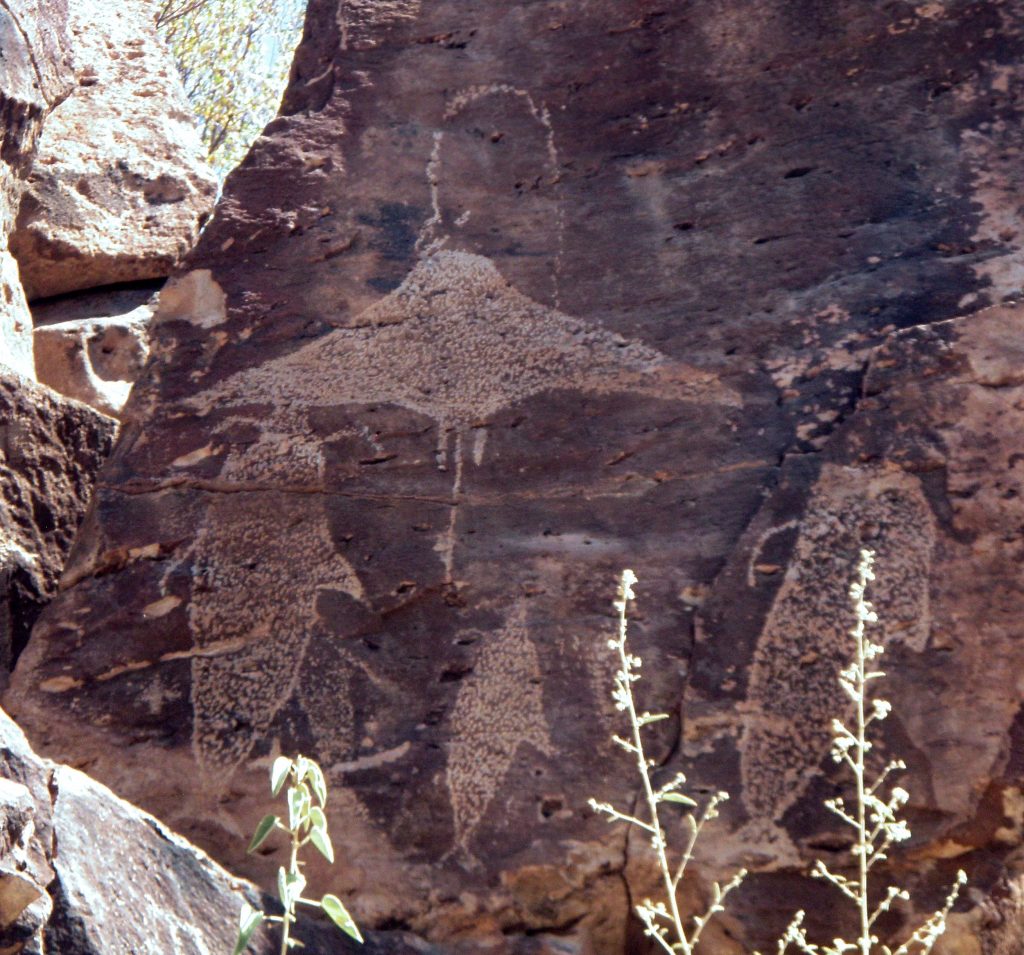
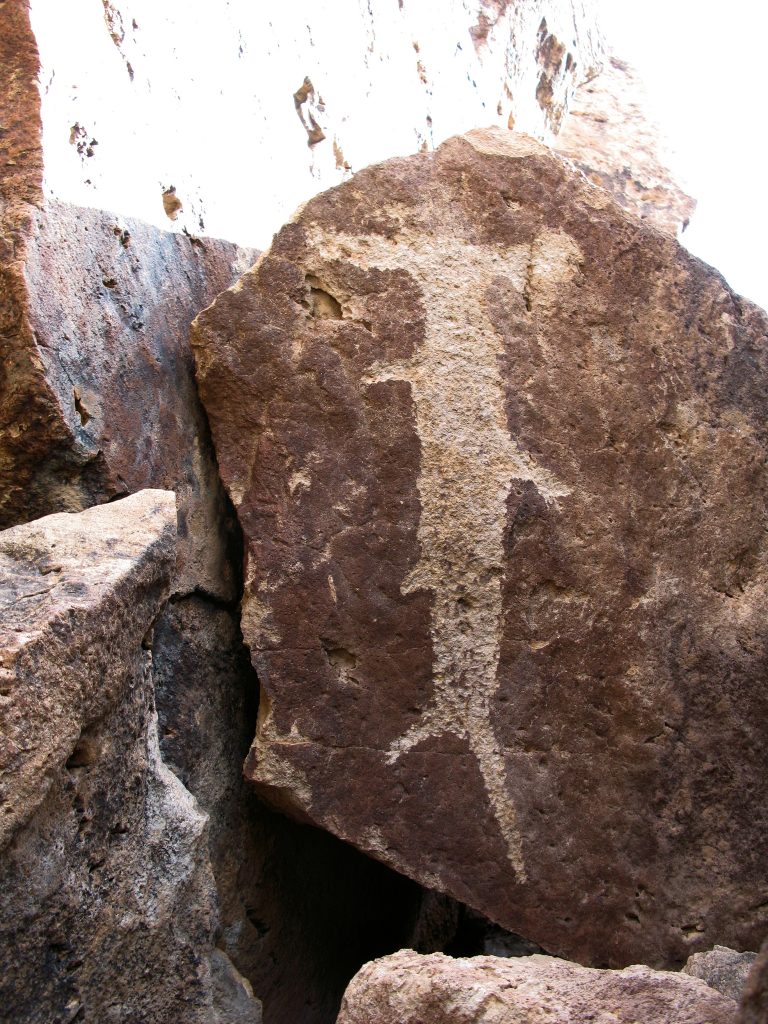
Most of the glyphs at this site are marine in nature which is somewhat surprising considering the distance from the ocean. Here is a rendition of what seems to be a Hammerhead Shark. Note the head is drawn as viewed from above but the rest of the body is viewed from the side. Again, a fully pecked interior.
Photo WS 08 by Bruce Schweers
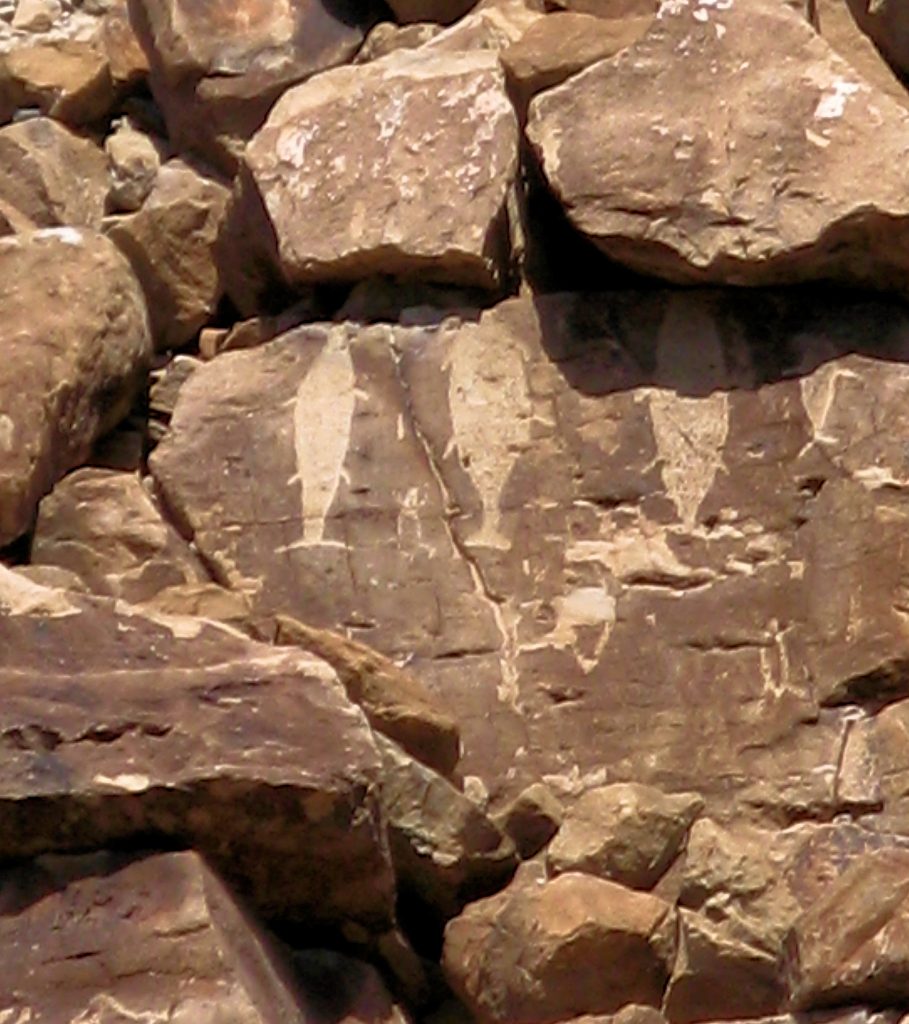
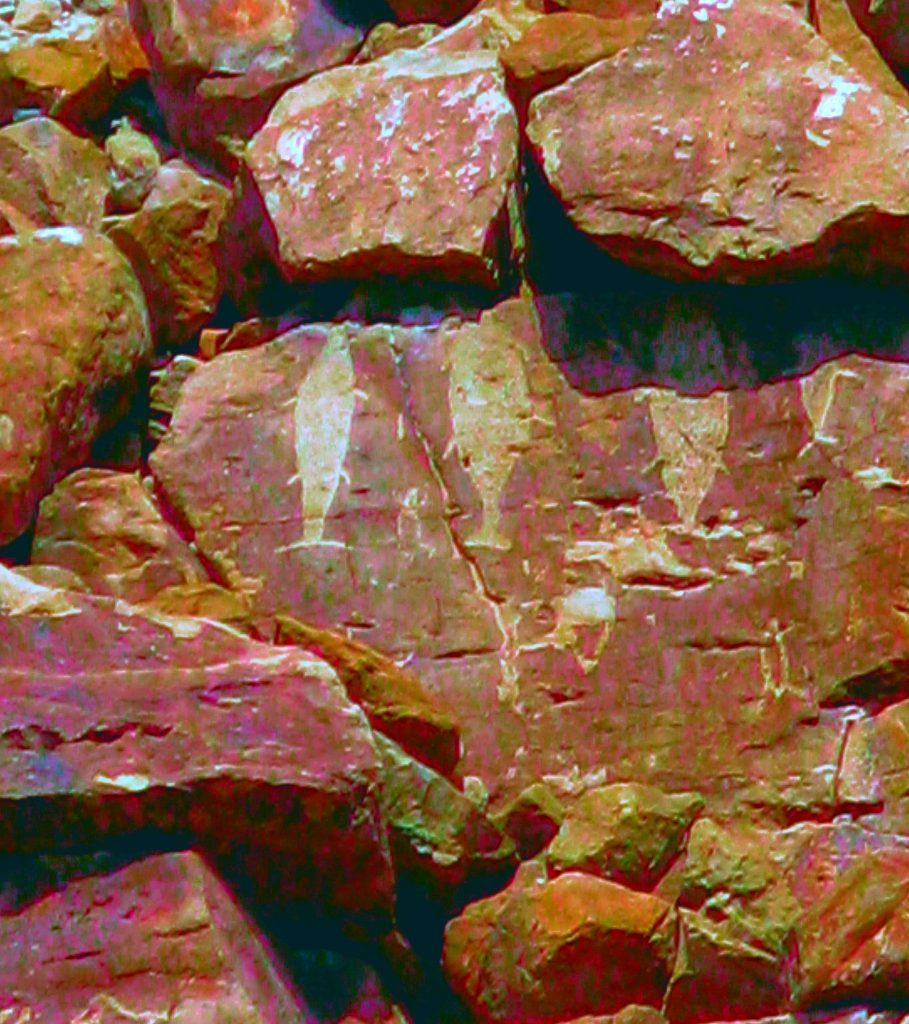
Above is a panel with a series of multi-finned fish shown with head up, fully pecked interiors.
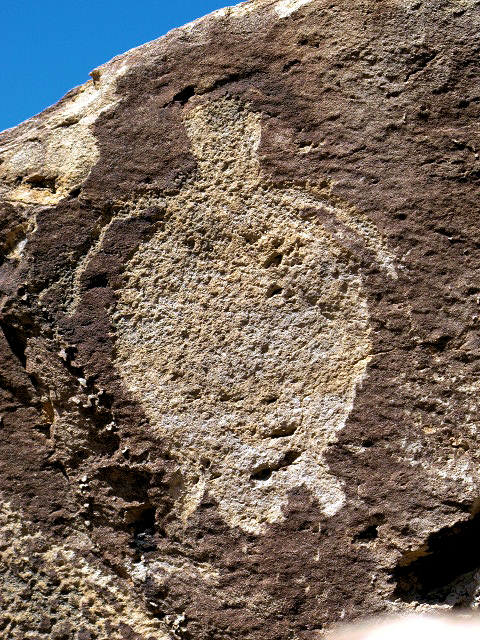
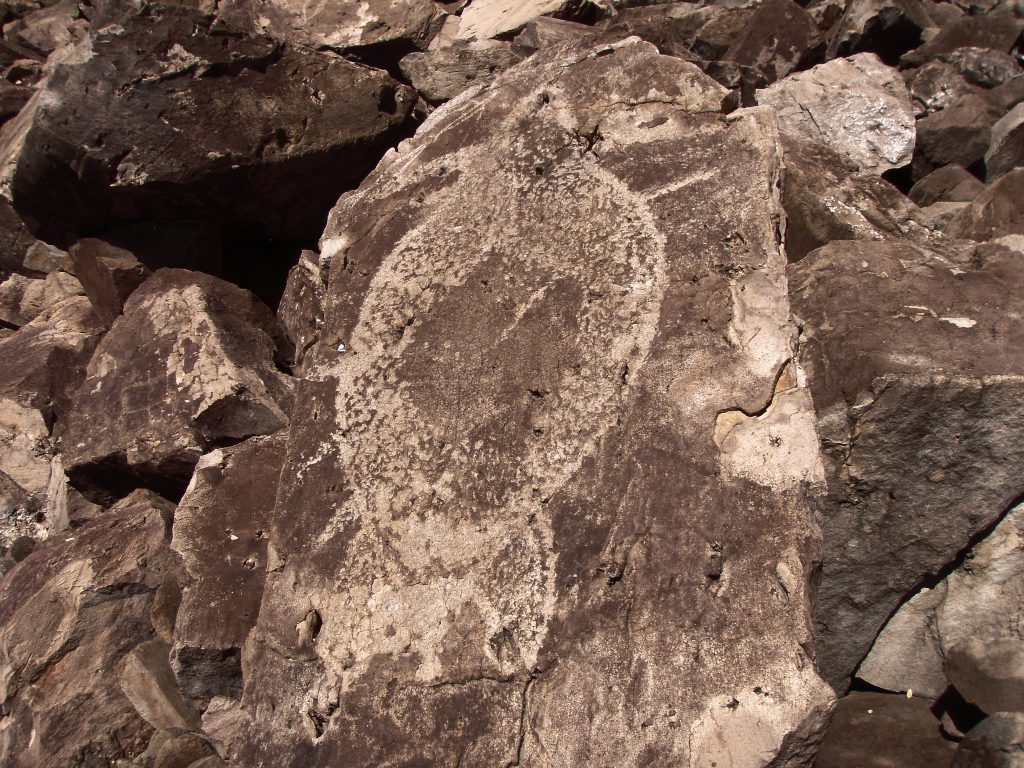
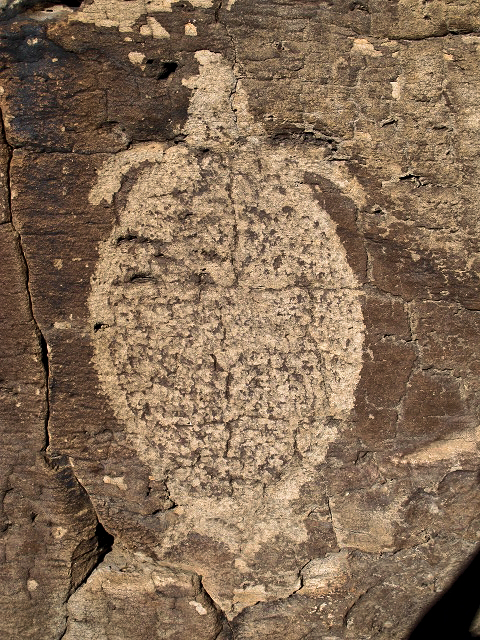
Above, shows three of the many images of turtles to be found at this site. The lower one with a partially pecked interior.
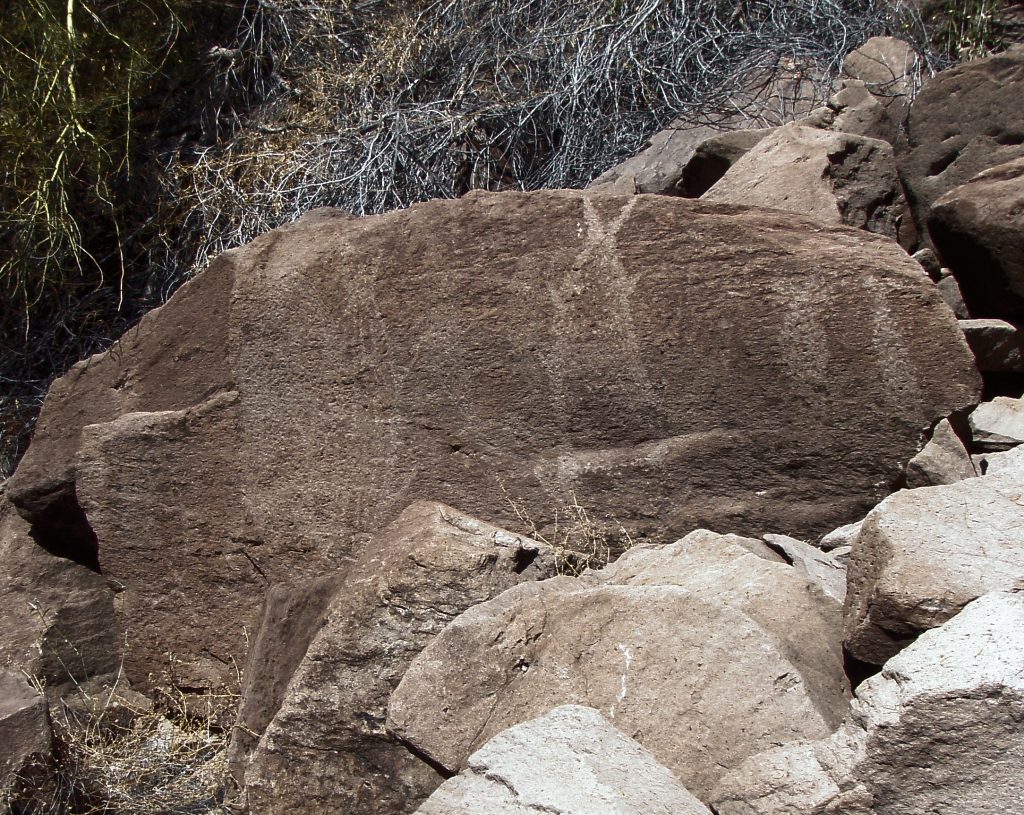
Here is a grouping of fish, the majority of which are displayed with tails up. I wonder why?
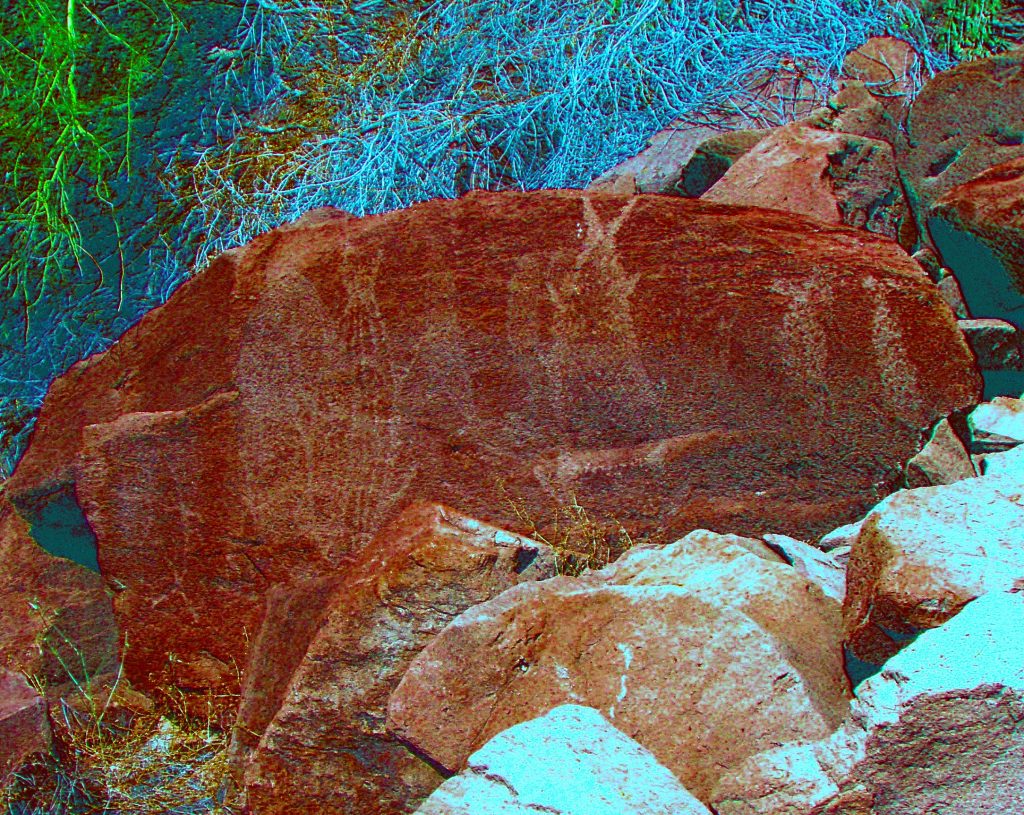
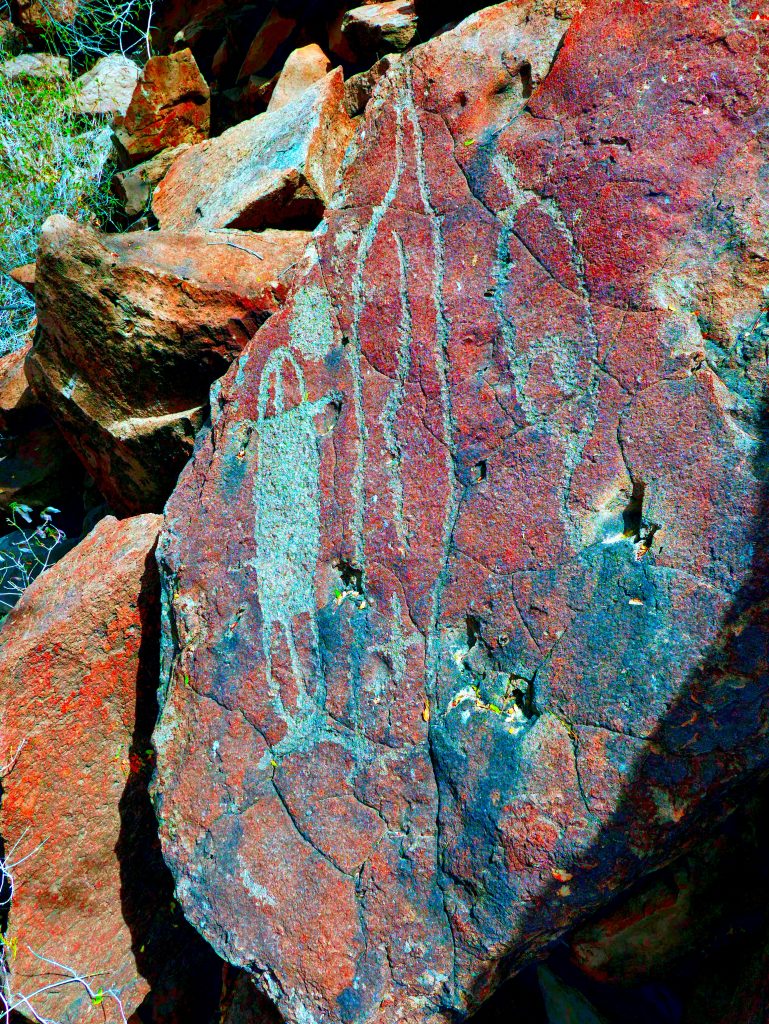
Here is a grouping of: on the left, a fish type of creature about 30cms long. In the centre an abstract creature perhaps, and on the right another abstract.
photo WS 21_lab by author
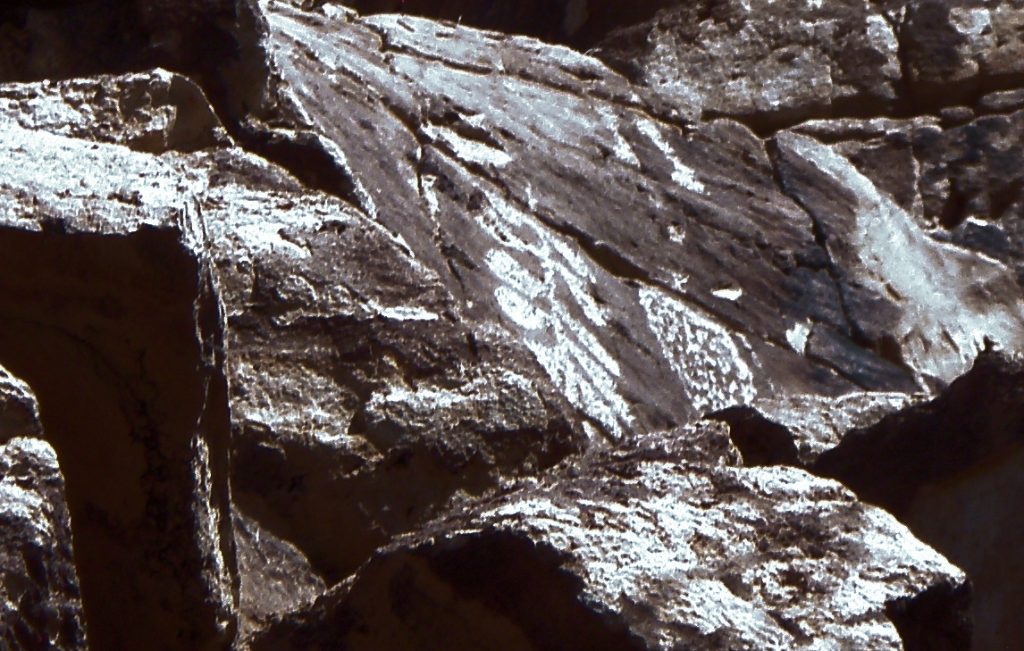
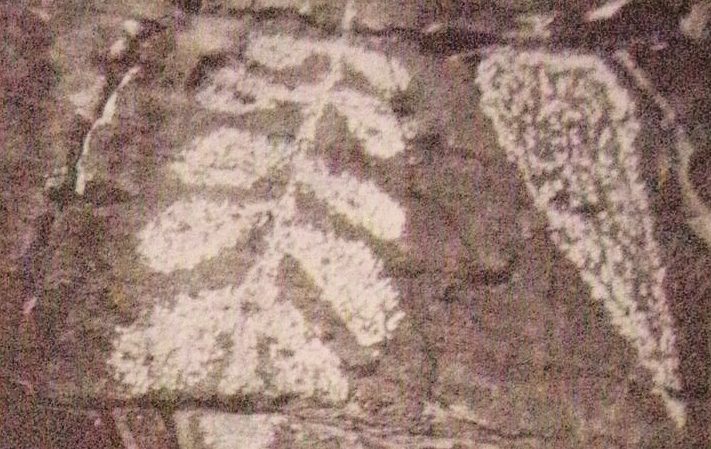
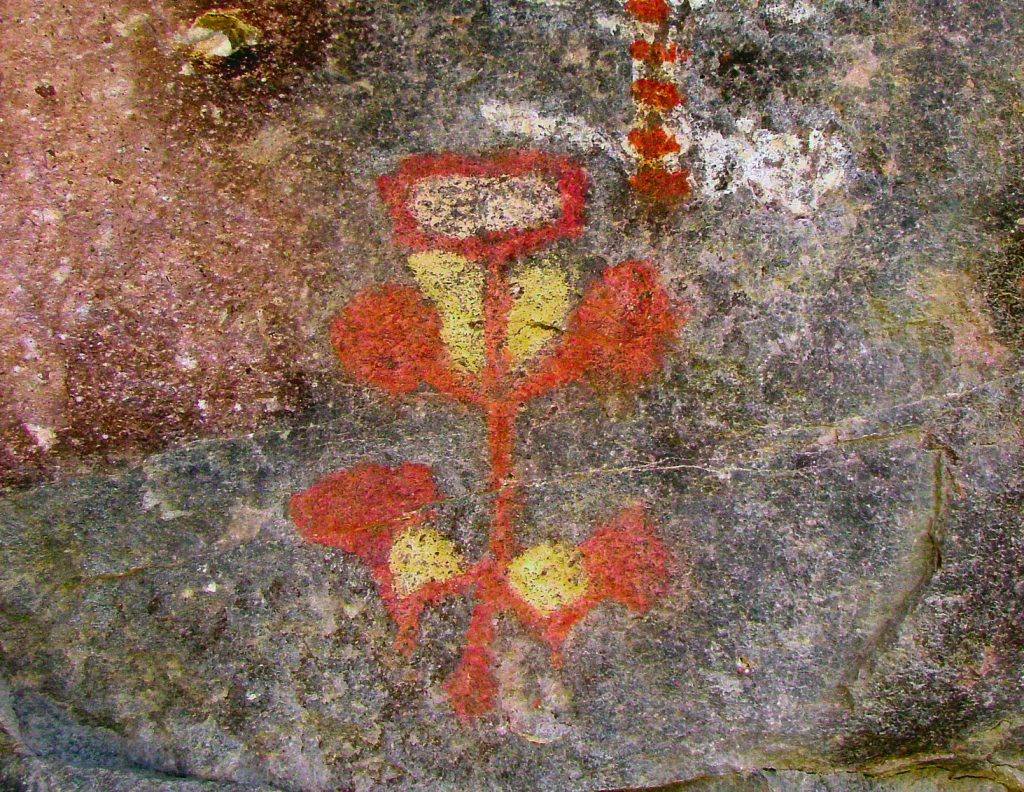
See above photos. . . On another close by rock (to the left of the Sea Goddess) there is a full size figure of what could be interpreted as the flowering head of an Agave plant and along side of it could be the tapering tubular root of the same plant, both figures fully pecked. Note: on the right, a similar painted picture of an Agave plant’s flowering head is rendered in red and yellow at the Montevideo site near Bahia de Los Angeles
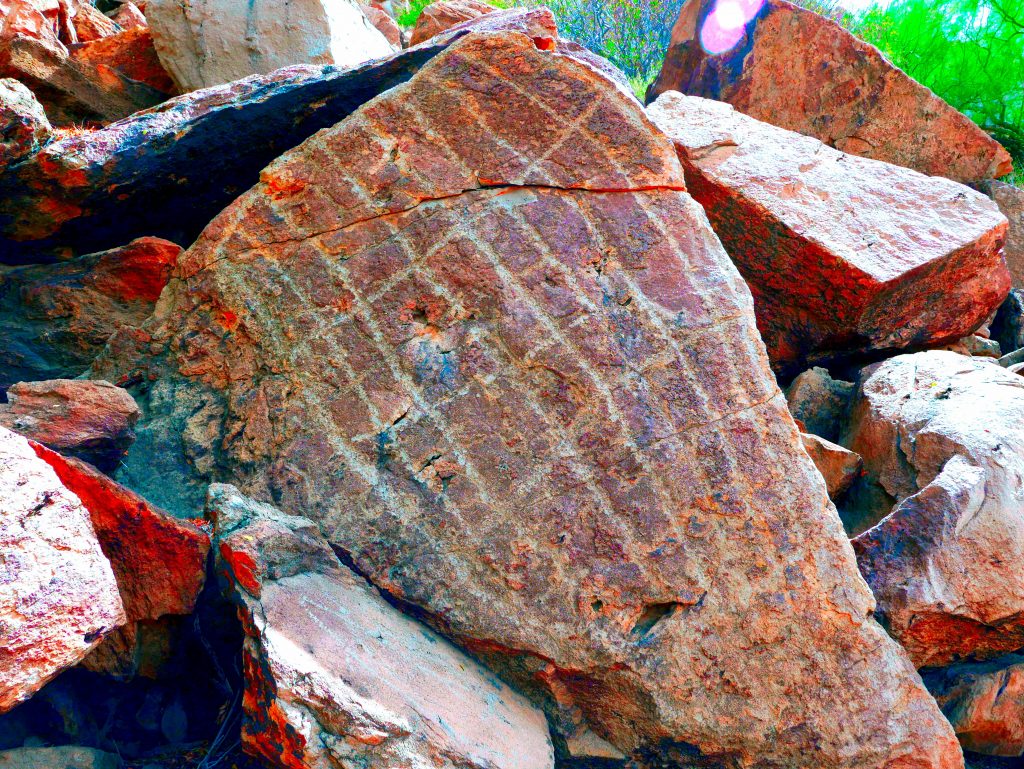
This image has the outline drawn along the edge of the rock ‘incorporating’ the shape of the rock. The interior is blocked off into sections. Just like the conical fish traps used in tidal waters. Image is about 1.5 meters by 0.75 meters.
Photo WS 20_lab by author
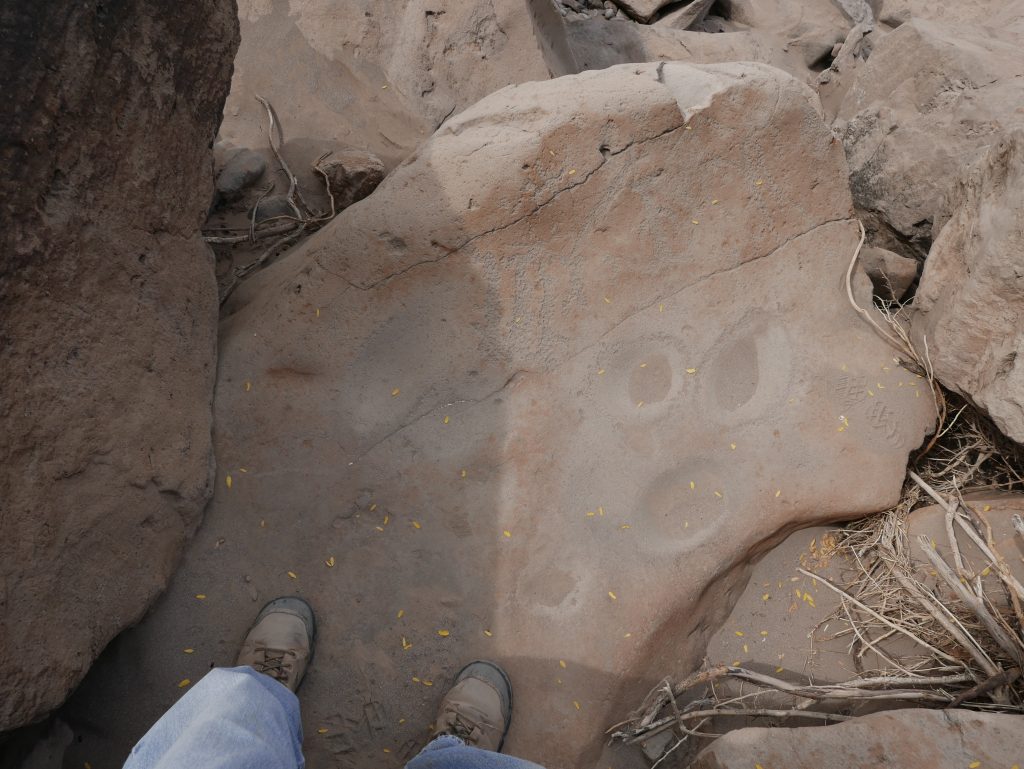
Close to arroyo level is this horizontal boulder with six metate depressions ground into it’s surface. Other glyphs too.
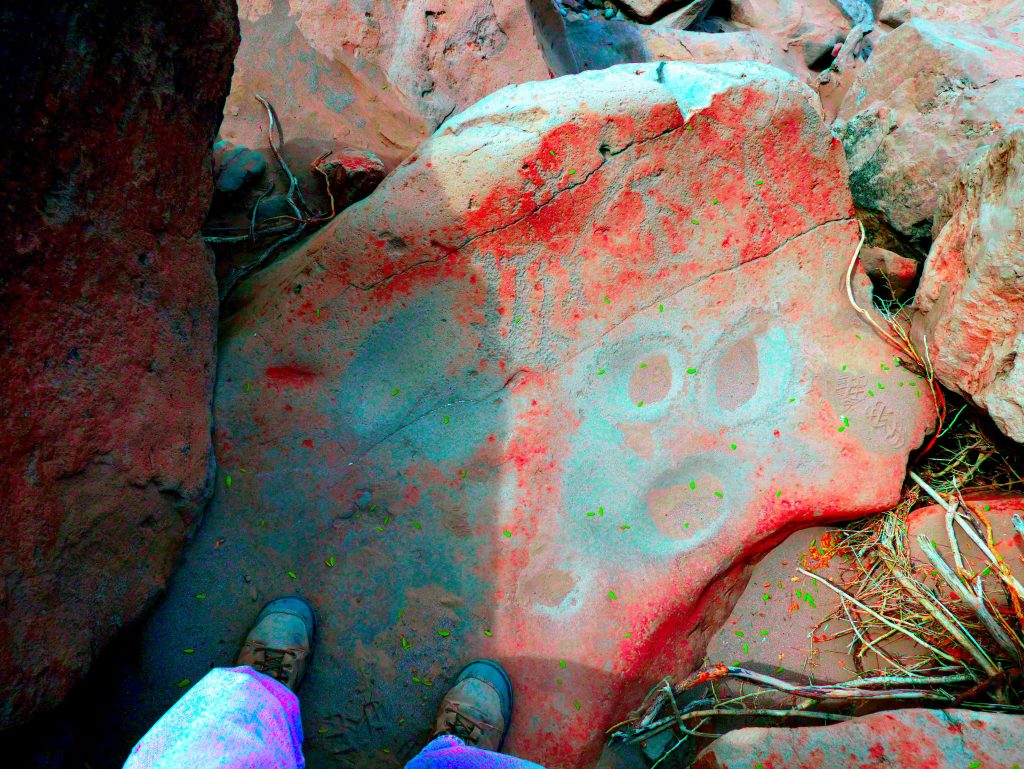
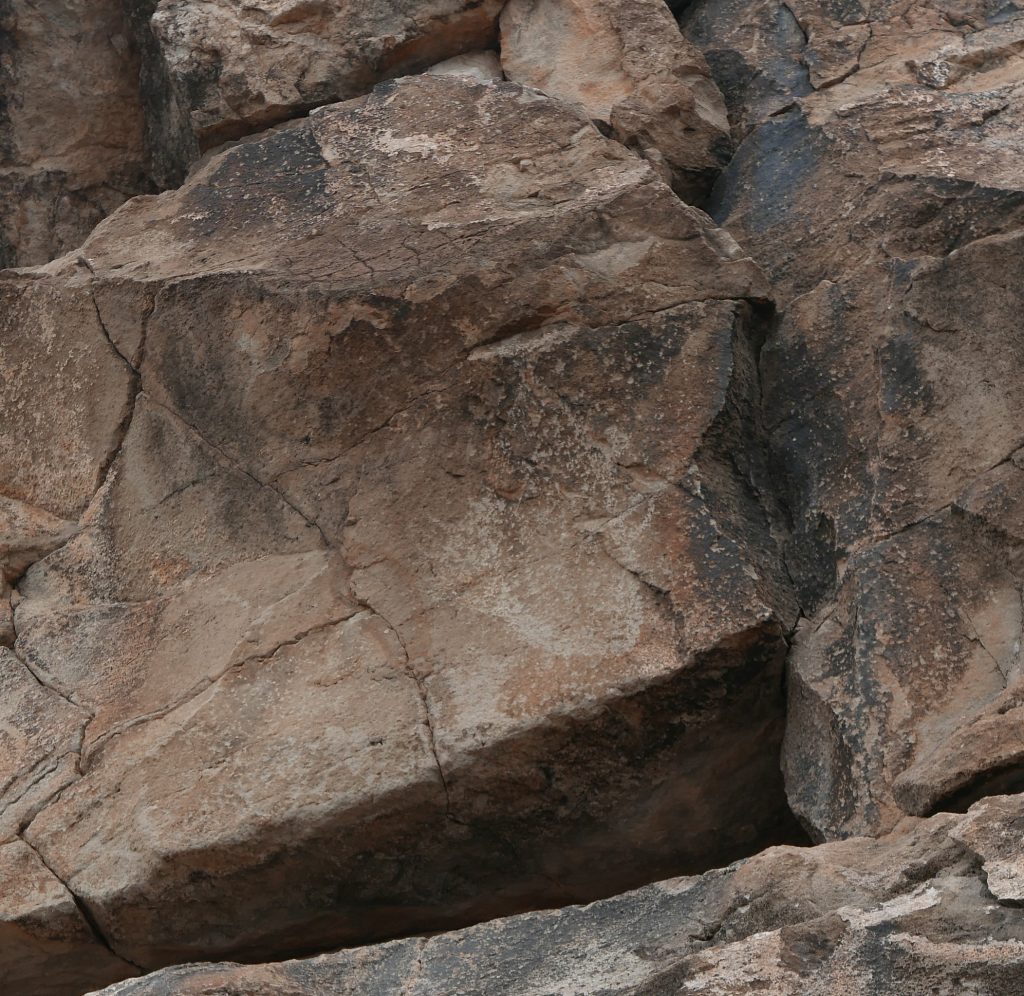
This image of a fish about 50cms long with the tail up. Look at the raised and prominent dorsal fin. A Rooster Fish? Also the tail is incorporated into a cleft in the rock. The cleft looks to have been worked wider too.
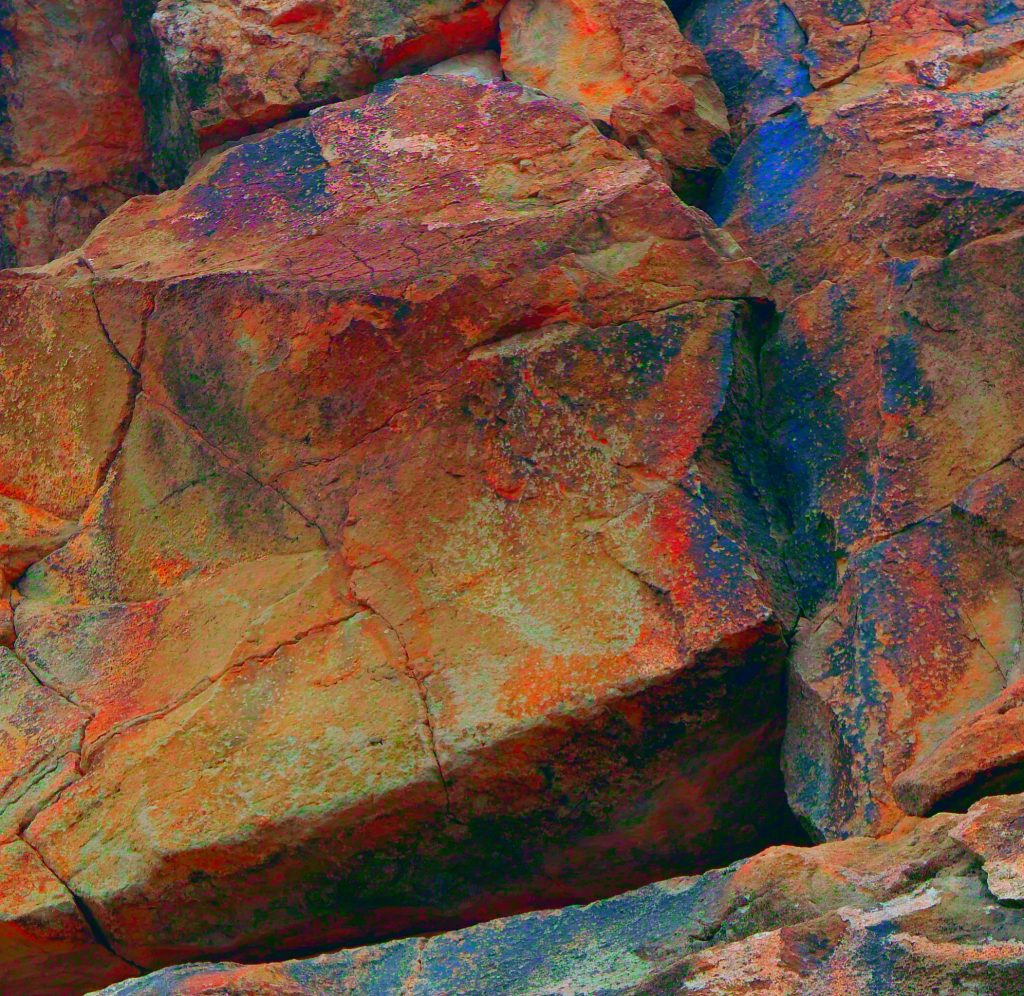
Now for something completely different
The photos up till now have shown petroglyphs made on rocks that are the most common at this site, a form of fine sandstone, laid down by sedimentation I believe. Any glyph formed on this rock will be fairly easy to make in it’s relatively soft surface and the result is a soft yellowish hue where the outer coating has been chipped away. I believe that these glyphs were made by the Cochimi during their use of this site and they are fairly recent, perhaps within the last thousand years or so. The techniques they used involved a scratching of the surface of the rock combined with a mild form of chipping so as to produce an etching that is relatively shallow. Some outlines are made by scratching only, resulting in an even shallower outline. All of the glyphs at this site produced in this way have no patination, speaking therefore of a young age. This includes the Sea Goddess.
What I will show now is totally different. There are a few rocks close to the arroyo level that have a different composition, a form of Andesite I believe. Where they came from, I don’t know. This rock is Gray in colour and is quite hard and dense in nature. Flakes of this stone can hold an adequate cutting edge if properly knapped. The petroglyph elements on these rocks are predominately fish, tending to be quite narrow, with a forked tail and internal lines either longitudinal or crosswise. Also they are incised much deeper than the glyphs shown earlier requiring repeated chiseling of the rock in the same spot to get the desired depth. The width of the incised lines are also wider. A function of the depth perhaps, but extra line width may be a deliberate action. All of this work requiring a significant amount of time to produce. This is the work of a race of people who used this site before the Cochimi. I will refer to them as the ‘Ancients.’ The work done by the Ancients on the rocks at arroyo level has been scoured by Chubasco waters and consequently those have absolutely no patina for comparative purposes. However, there are a few renditions on other rocks (that I will show you) that have not been scoured that show an extremely dark patina in the inscribed portion of the glyph. I am prepared to apply a date of some 10,000 to 20,000 years before present for those petroglyphs. This time frame for a group of people to be in Baja does not contradict with the current beliefs as to the peopling of this continent via the Bering Land Bridge or even earlier by sea-faring hunters.
Further, if you feel that those dates are fairly close, then I would like to suggest that the climate and vegetation of this area, at that time, (close to early post-glaciation) would support a belief that the Piedras Pintados site was at a location alongside the banks of a flowing river, perhaps with sea going fish in it. . . . I told you it was completely different!
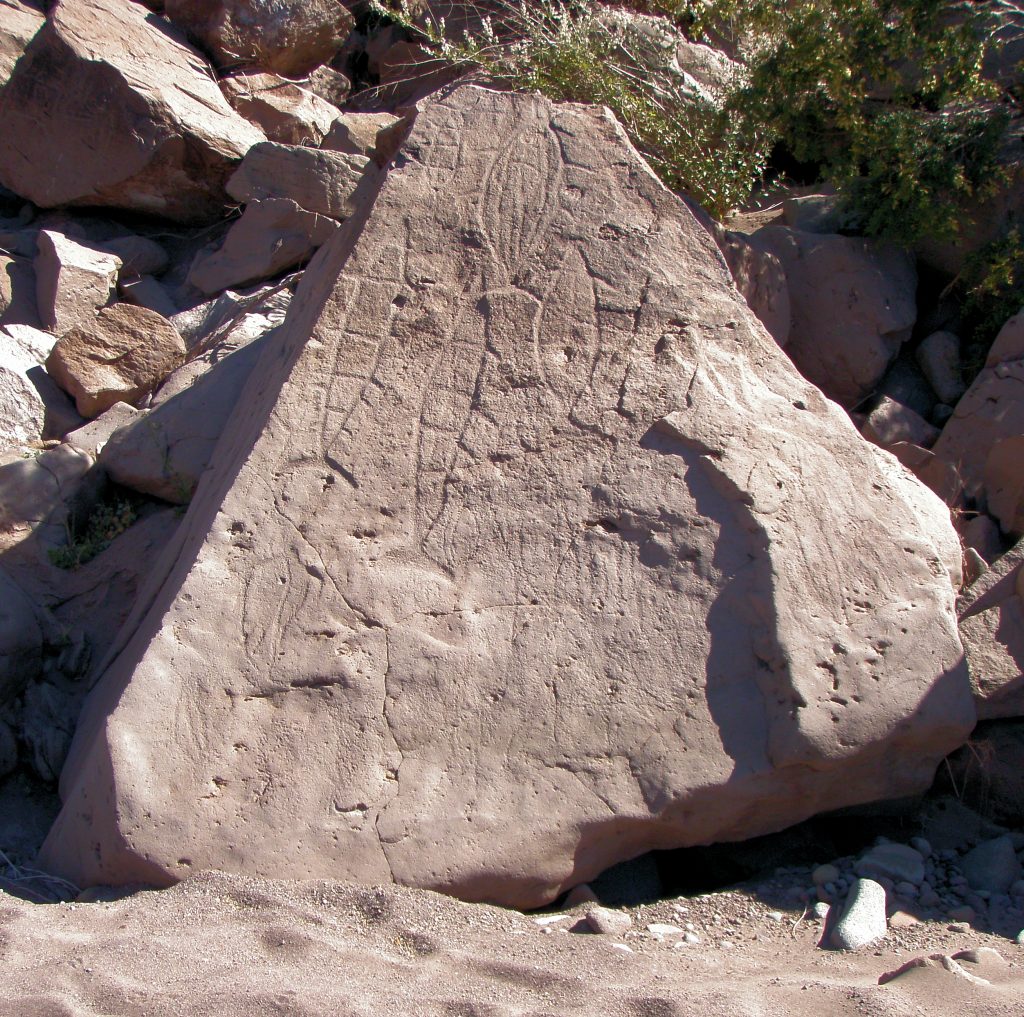
This 2 meter high rock is triangular shaped and is at arroyo level. Petroglyphs by the ‘Ancients.’ Long narrow fish. Interior lines, Deep and wide lines. Forked tails. Multi fins.
photo WS 19 not enhanced, by author.
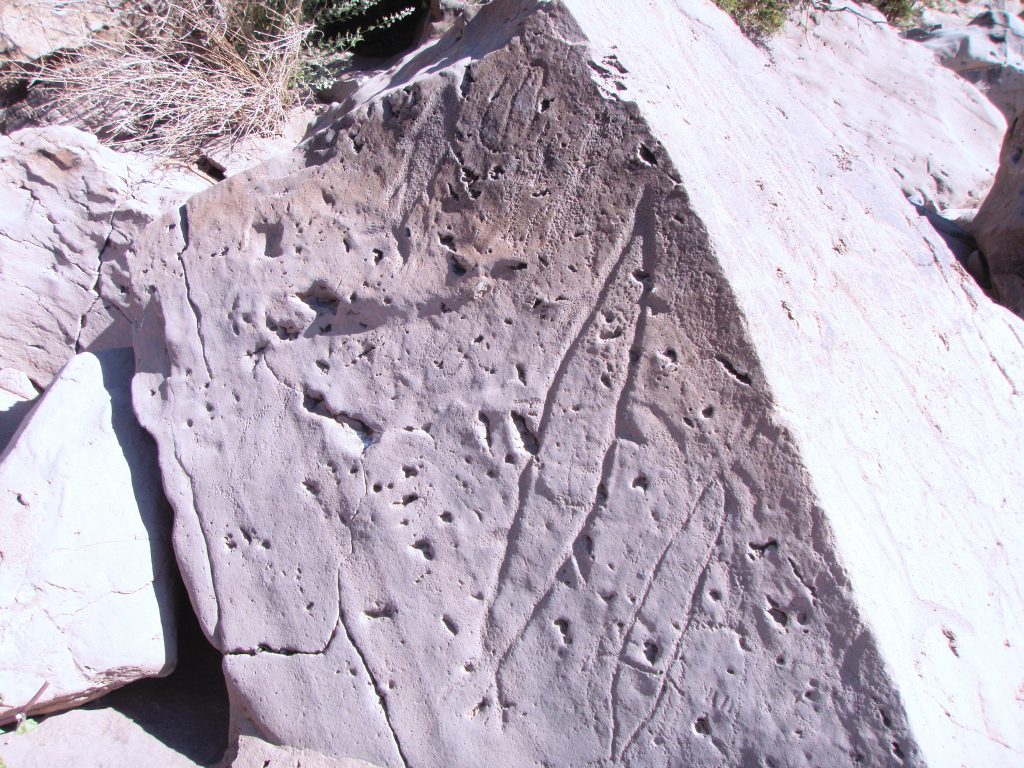
The same rock, later in the day with sun shining on north side. This side somewhat protected by north flowing waters. Shows very deep incised lines in the largest fish shown.
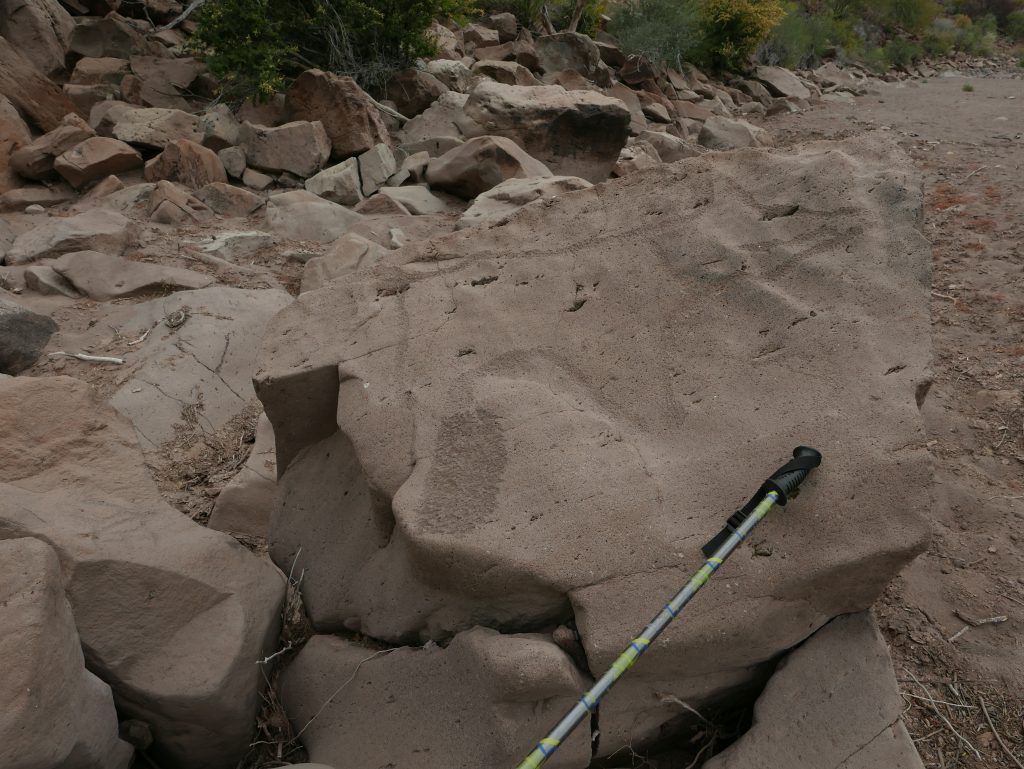
Further south from the pyramid rock, this rock showing a glyph of perhaps a coyote with the eye incorporated into a cleft in the rock. Note the wide scribed lines of the Ancients.
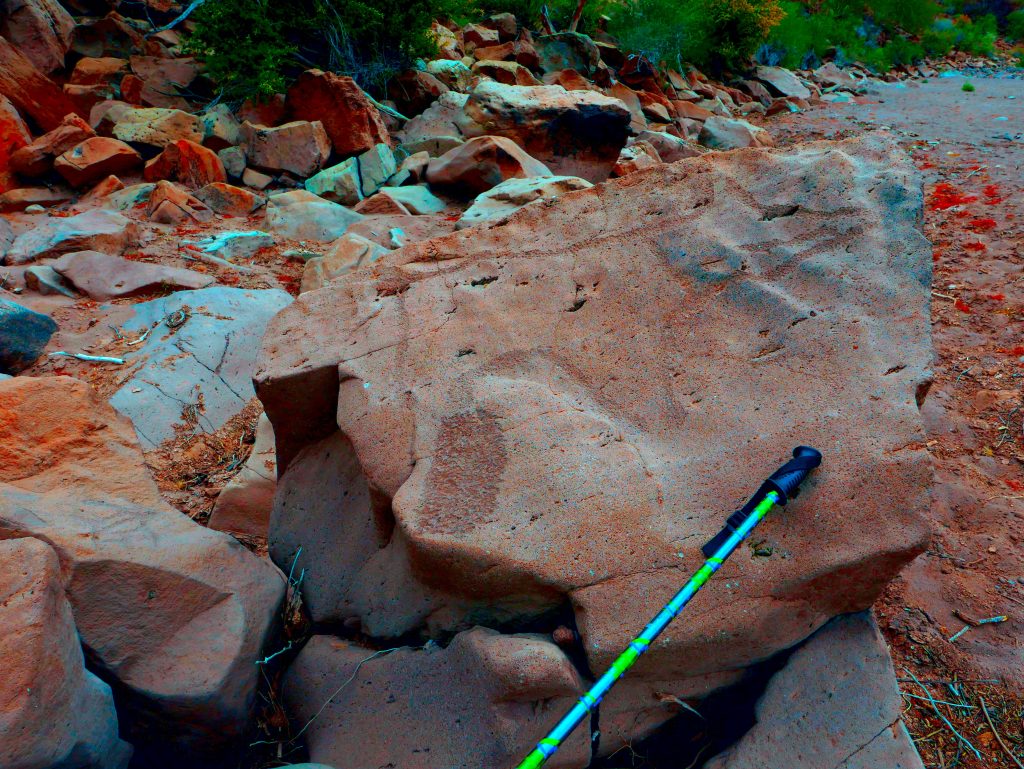
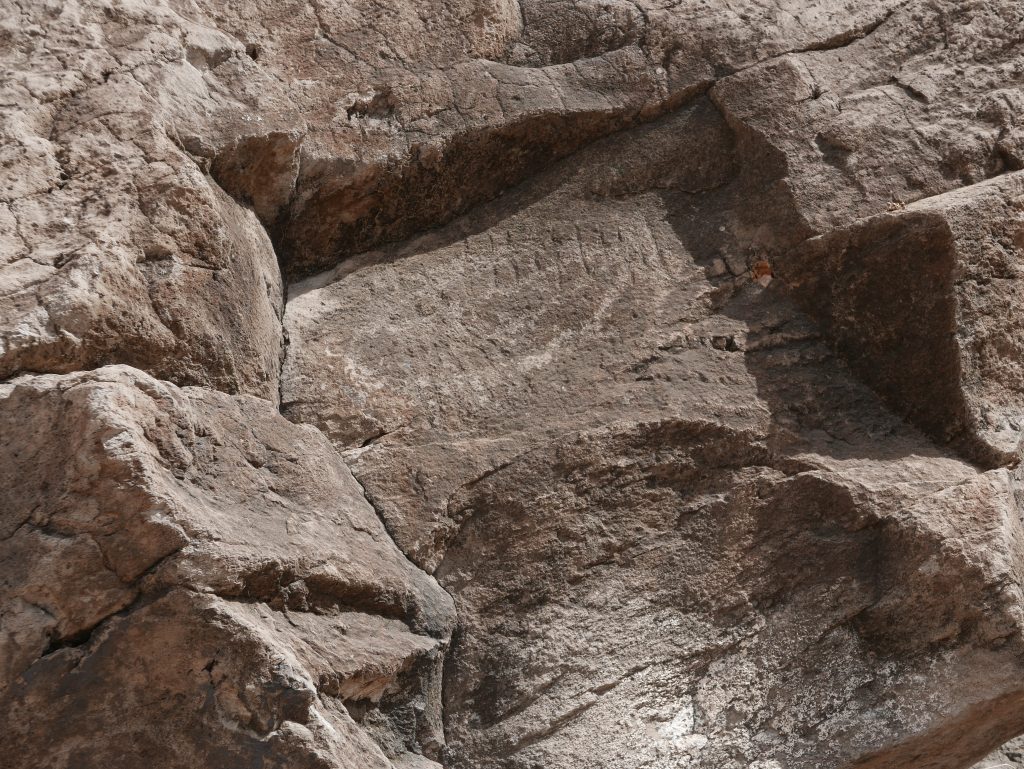
Close to the north end of the West Side site, about 3 meters above arroyo level in a small niche is this 35cm long fish with multiple lines across it. Deeply patinated
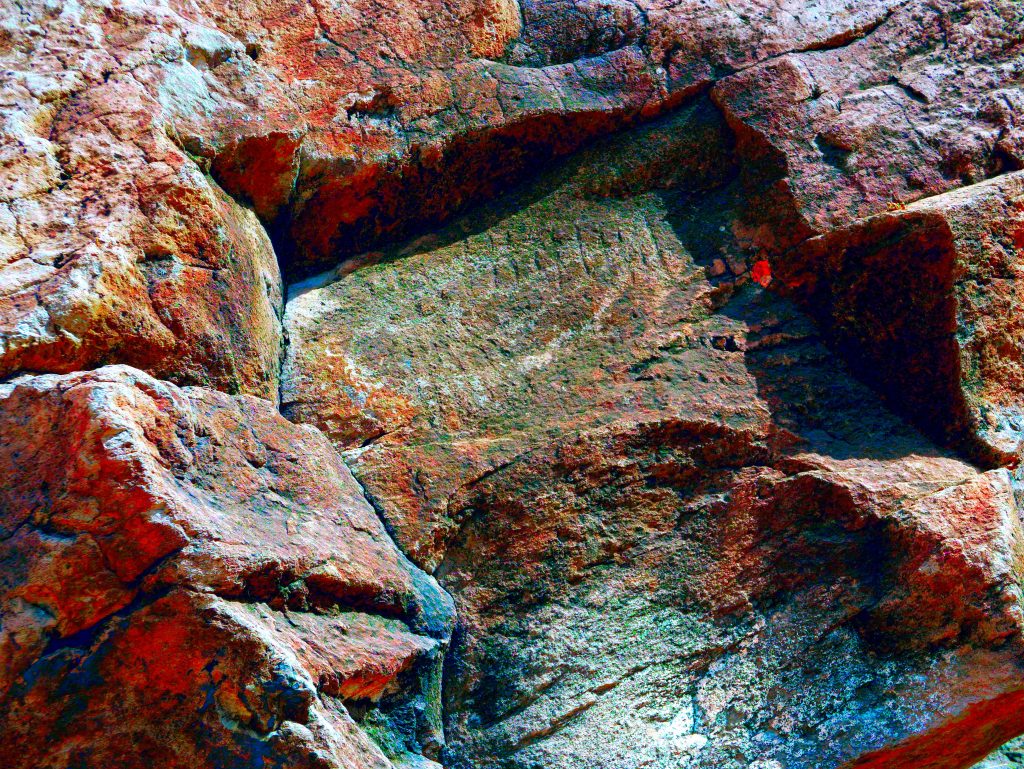
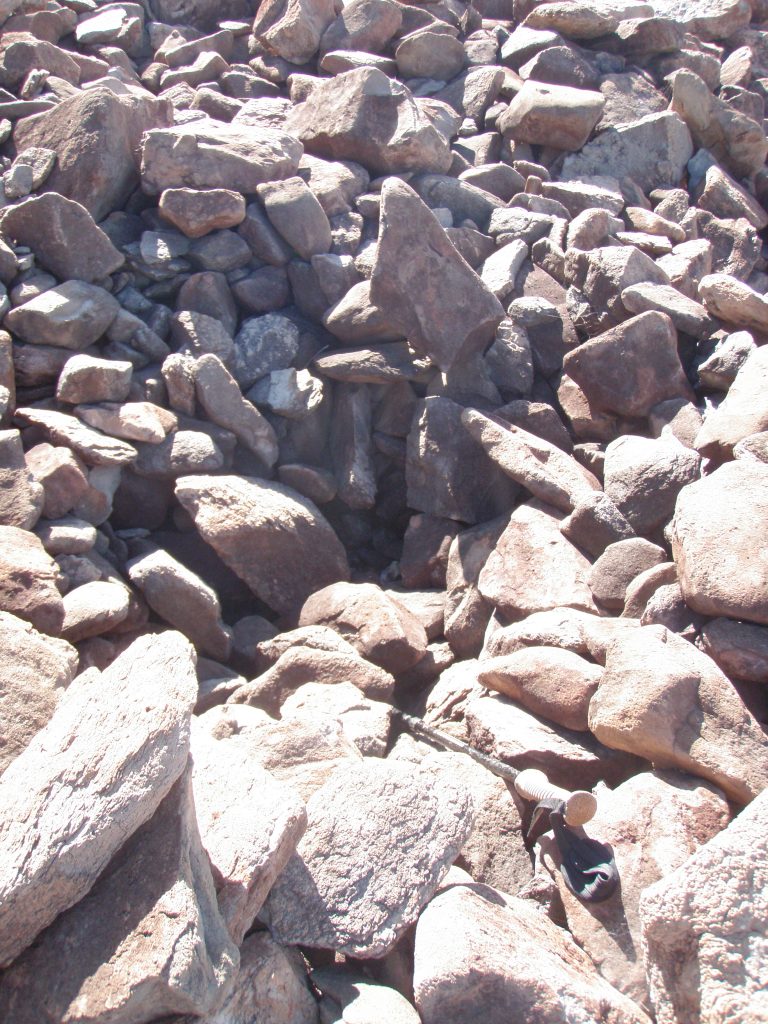
Lookout Post. Partially sluffed in with rock, but still a recognizable depression about 1 meter deep. This Post is located about 100 meters south of the Sea Goddess in an area of loose rubble. There are two more on the East Side site. This suggests that guards were posted to watch for other tribes or rancherias who may not have been welcome. Two similar Posts located at Los Cocos beach, one near Buenaventura. One in Santa Barbara arroyo.
photo Lookout Post WS by author
